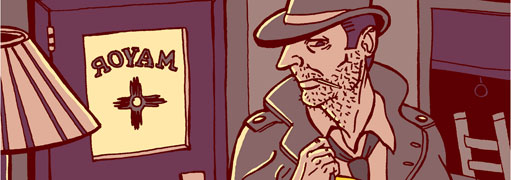When the latest rash of officer-involved shootings had just begun in 2009, a transition team created a report for the incoming mayor about the Albuquerque Police Department. It pointed to corruption, fear of retaliation on the force, criticisms from the public and problems with APD’s leadership. But Mayor Richard Berry may have never seen that version of the report. Two years later, retired APD Sgt. Paul Heh tried to address the City Council about the two versions of the report. Heh’s presentation was cut off, and he was not allowed to discuss the differences between drafts. Heh says he wonders if Berry would have chosen to reappoint Police Chief Ray Schultz if the original had reached the mayor’s desk as written.Heh was not on that transition team but has obtained copies of two conflicting documents. Bernalillo County Commissioner Wayne Johnson was a member of the transition team along with eight others. He says the group was approaching a consensus for a final version but didn’t get a chance to finish. The process was cut short when members were told to wrap it up and submit what they had. Johnson says the team was working on a draft that pointed out systemic problems within the department and asked whether Police Chief Schultz needed to be replaced. “The draft submitted to the mayor was not voted on and was not the direct work product of the committee,” Johnson says. “We were asked to do an honest assessment of the police department, good and bad. And we were doing that. Then we were not given enough time to finish the report.”The team made 41 recommendations. The modified report that went to Berry had 38. Still, critical observations in the original never crossed the mayor’s desk. Johnson says he doesn’t know who softened the report. The team reviewed the work of nationally known police expert Neal Trautman, including a paper titled “How & Why a Department or Jail Becomes Corrupt.” Members of the group found that aspects of APD could indicate shady leadership, according to Trautman’s “Continuum of Corruption” guidelines.Fear among the rank-and-file is one of the major clues that a department is rotting, according to Trautman’s paper. Others include: bitterness and harsh criticism by large groups of citizens; bursts of open defiance of administrators; workers rationalizing unethical actions during conversations with each other; and a departmental attitude of keeping corruption out of the media. Avoiding bad press, Trautman writes, becomes more important than addressing and disciplining corrupt acts.The team, in its first draft, observed that members of APD’s command were defensive and ignored requests for meetings. Some commanders met with team members but feared retaliation from their superiors, according to the original report. Field officers told the team they were afraid to identify problems and that higher-ups seemed distant from the cops on the front lines. Supervisors reported that they felt out of the loop. Bob Martinez served as chair of the police transition team. He is president of the local chapter of the Fraternal Order of Police. The modified report bears his name on the cover sheet.Martinez says it was his job as chairman to wrap things up and reflect the views of the majority of the group. “It was done and approved by the committee.” There may have been a minority opposition to what was given to Berry, he adds.Johnson and other members contend this is not the case. Instead, he says, the transition team never finally approved anything, and critical observations of APD brass were deleted from the final draft.The Alibi spoke with another member of the transition team who wishes to remain anonymous, “Steve.” He says at least half of the nine-member transition team felt there were significant problems in the police department, and a change in leadership was recommended. He also says the report was reviewed by newly appointed Public Safety Director Darren White before it was sent to Berry. The softer version was given to the mayor before he reappointed Chief Schultz. Steve also wonders if Berry would have made a different decision if he had seen all the information the team collected.Dayna Gardner, Berry’s spokesperson, did not directly address the question of whether White or anyone else reviewed and changed the report. Gardner also didn’t say whether Berry knew about an earlier version identifying systemic problems. More than 200 volunteers analyzed each of the city’s departments after the 2009 mayoral election, she says. Berry’s transition effort was led by Sherman McCorkle, a longtime supporter of White. “Each chairman, or their respective designate, submitted a final consensus report reflecting their committee’s work, findings and recommendations,” Gardner says.All of this matters, Sgt. Heh says, because the police transition team did a thorough review of the department in 2009, highlighting problems that have continued to plague the department. Both he and Commissioner Johnson say the first version, though rushed, reflected work by members of the community and pinpointed solvable problems. “We were asked to take an honest, hard look at the department," Johnson says, "then not allowed to finish the task."Heh says it appears to him that the Berry administration hired police leaders who would rather hide or deny APD’s problems than address them. “It doesn’t help to put a Band-Aid on a major wound.”
Read the conflicting reports in full at alibi.com.



